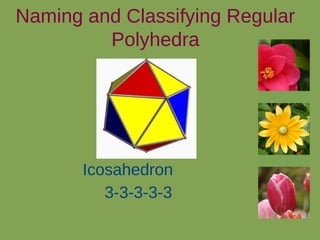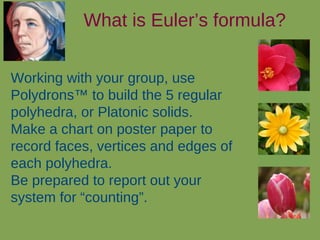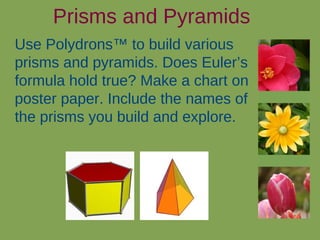Intro to Solids, Nets, and Euler
- 1. Intro to Solids Nets and Euler
- 2. Activator: ŌĆó Write the name of at least 5 different types of geometric solids.
- 4. Naming and Classifying Regular Polyhedra Tetrahedron 3-3-3
- 5. Naming and Classifying Regular Polyhedra Hexahedron 4-4-4
- 6. Naming and Classifying Regular Polyhedra Octahedron 3-3-3-3
- 7. Naming and Classifying Regular Polyhedra Dodecahedron 5-5-5
- 8. Naming and Classifying Regular Polyhedra Icosahedron 3-3-3-3-3
- 9. Faces, Vertices, Edges: Oh my! Explore counting faces, vertices and edges with this web app.
- 10. Who was Euler? Euler was a Swiss mathematician who was famous for seeing a relationship among faces, vertices and edges of solid shapes.
- 11. What is EulerŌĆÖs formula? Working with your group, use PolydronsŌäó to build the 5 regular polyhedra, or Platonic solids. Make a chart on poster paper to record faces, vertices and edges of each polyhedra. Be prepared to report out your system for ŌĆ£countingŌĆØ.
- 12. The Five Regular Polyhedra Vertex Name Faces Vertices Edges Config Tetra- 3-3-3 hedron Hexa- 4-4-4 hedron Octa- 3-3-3-3 hedron Dodeca- 5-5-5 hedron Icosa- 3-3-3-3-3 hedron
- 13. Prisms and Pyramids Use PolydronsŌäó to build various prisms and pyramids. Does EulerŌĆÖs formula hold true? Make a chart on poster paper. Include the names of the prisms you build and explore.
- 14. Lesson 49 Practice Problems p. 323 a - f Copy each problem/ picture. Show work or explain each answer.
- 15. Individual Exit Slip p. 324 #10 Manufacturing Application Connector Pipes Fiberboard Metal Strips















